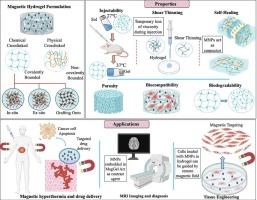Magnetic hydrogel (MagGel): An evolutionary pedestal for anticancer therapy
IF 20.3
1区 化学
Q1 CHEMISTRY, INORGANIC & NUCLEAR
引用次数: 0
Abstract
Recent advancement in biomaterials have led to the development of magnetic hydrogel as promising tool for anticancer therapy. Magnetic hydrogels improve injectability over bare nanoparticles by controlling particle dispersion and reducing aggregation, ensuring uniform delivery and minimizing clogging, thereby enhancing anticancer therapy effectiveness and safety. This review explores the fundamental crosslinking methodologies and chemical strategies for the formation of hydrogels, transitioning into detailed discussions on the synthesis of magnetic hydrogels, emphasizing their unique properties essential for biomedical applications. Key properties such as injectability, shear thinning, biocompatibility, porosity, mechanical properties, and biodegradability underpinning the efficacy of magnetic hydrogels in biomedical applications are discussed. Furthermore, the review highlights the diverse applications of magnetic hydrogels in the biomedical field, including hyperthermia, MRI-guided therapy, targeted drug delivery, and tissue engineering. These properties and applications demonstrate the potential of magnetic hydrogels to revolutionize cancer treatment and other medical therapies, offering a multifunctional platform that can address various biomedical challenges with enhanced precision and effectiveness. Finally, future research trends and applications of magnetic hydrogels are also recommended and examined.

磁性水凝胶(MagGel):抗癌疗法的进化基座
生物材料领域的最新进展促使磁性水凝胶的开发,使其成为抗癌治疗的理想工具。与裸纳米粒子相比,磁性水凝胶通过控制粒子分散、减少聚集、确保均匀给药和最大限度地减少堵塞,提高了注射性,从而增强了抗癌治疗的有效性和安全性。本综述探讨了形成水凝胶的基本交联方法和化学策略,然后详细讨论了磁性水凝胶的合成,强调了它们在生物医学应用中必不可少的独特性能。文中讨论了磁性水凝胶在生物医学应用中发挥功效的关键特性,如注射性、剪切稀化、生物相容性、孔隙率、机械特性和生物降解性。此外,综述还重点介绍了磁性水凝胶在生物医学领域的各种应用,包括热疗、核磁共振成像引导治疗、靶向给药和组织工程。这些特性和应用表明,磁性水凝胶具有彻底改变癌症治疗和其他医学疗法的潜力,它提供了一个多功能平台,可以更精确、更有效地应对各种生物医学挑战。最后,还推荐并探讨了磁性水凝胶未来的研究趋势和应用。
本文章由计算机程序翻译,如有差异,请以英文原文为准。
求助全文
约1分钟内获得全文
求助全文
来源期刊

Coordination Chemistry Reviews
化学-无机化学与核化学
CiteScore
34.30
自引率
5.30%
发文量
457
审稿时长
54 days
期刊介绍:
Coordination Chemistry Reviews offers rapid publication of review articles on current and significant topics in coordination chemistry, encompassing organometallic, supramolecular, theoretical, and bioinorganic chemistry. It also covers catalysis, materials chemistry, and metal-organic frameworks from a coordination chemistry perspective. Reviews summarize recent developments or discuss specific techniques, welcoming contributions from both established and emerging researchers.
The journal releases special issues on timely subjects, including those featuring contributions from specific regions or conferences. Occasional full-length book articles are also featured. Additionally, special volumes cover annual reviews of main group chemistry, transition metal group chemistry, and organometallic chemistry. These comprehensive reviews are vital resources for those engaged in coordination chemistry, further establishing Coordination Chemistry Reviews as a hub for insightful surveys in inorganic and physical inorganic chemistry.
 求助内容:
求助内容: 应助结果提醒方式:
应助结果提醒方式:


